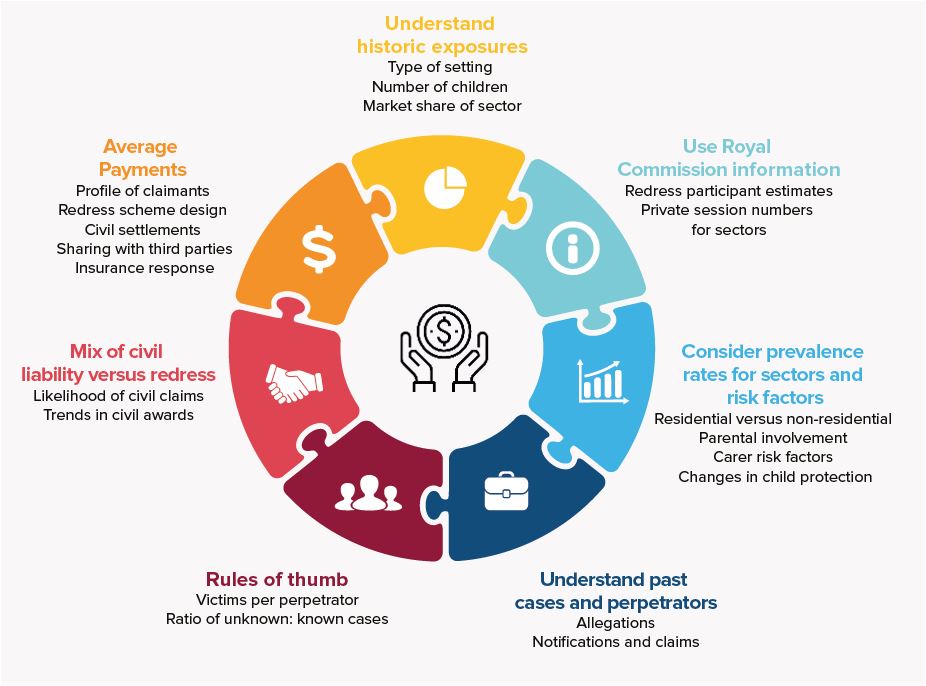
The role of the actuary in social schemes – National Redress Scheme for Child Sexual Abuse
The Royal Commission engaged actuaries at Finity Consulting to conduct an actuarial assessment of the potential costs of an Australian National Redress Scheme, estimating the scheme would cost around $4 billion. Since then, Finity have worked closely with many organisations to help estimate their exposure to sexual abuse liabilities. Here, Danielle Casamento discusses the estimates and the framework used for assessing liabilities.
The Catalyst
In late 2012, the Royal Commission into Institutional Responses to Child Sexual Abuse was announced. Over 5 years, 42,000 calls, 26,000 letters and 8,000 private sessions later, the National Redress Scheme commenced on 1 July 2018 in response to the Royal Commission’s recommendations.
The Scheme
The National Redress Scheme will operate for 10 years and offers to eligible survivors of institutional child sexual abuse:
- a redress payment of up to $150,000,
- access to counselling and psychological services, and
- a direct personal response.
The scheme operates on an opt-in, responsible institution pays basis meaning responsible institutions need to join the scheme to allow fair access to redress for survivors. To date, all major governments and non-government institutions have committed to the scheme.
The scheme operates in parallel to civil litigation, as an alternative option for survivors of child sexual abuse. While scheme participants might not achieve the same level of financial compensation as they would in a civil claim, some of the benefits of redress for survivors include:
- The lower burden of proof required under redress, noting the passage of time and lack of records can add significant difficulty in suing the institution directly.
- The nature of the civil claim process can be source of re-traumatisation for victims.
- Historically, limitation periods, questions of vicarious liability and difficulties in identifying a proper defendant have made pursuing civil litigation difficult for survivors.
The scheme only covers victims of child sexual, and related physical abuse within institutions. This represents a small fraction of all historical child abuse within Australia with a high proportion of children experiencing institutional physical and emotional abuse (but not sexual abuse) and also noting that most abuse in Australia occurs outside of institutional contexts (particularly within families).
How can Actuaries assist?
No scheme can operate without consideration of design, costing and funding arrangements. In 2015, the Royal Commission engaged Finity Consulting to conduct an actuarial assessment of the potential costs of an Australian National Redress Scheme. This involved estimating the volume of participants that might report institutional child sexual abuse as well as considering the monetary payments, counselling and administrative costs of such a scheme.
How many survivors do we expect to come forward?
Based on our analysis, we estimated around 60,000 participants would approach a National Redress Scheme. The volume of participants was derived by extrapolating the number of survivors from past State-based redress schemes to a national level. One of the challenges of this analysis was that the past schemes only covered a limited range of institutional contexts while the proposed scheme was intended to be ‘universal’. Investigation and analysis of past civil claims and the Royal Commission’s private session data were coupled with actuarial techniques and judgement to estimate the varied ‘development’ of different institutional contexts.
How much will the scheme cost?
The cost per participant is dependent on how each abuse case is assessed and the corresponding payment awarded. Based on the Royal Commission’s recommended payment scale, which scored each participant based on severity, impact and additional factors, we estimated the scheme would cost around $4 billion. The assessment framework which will be used to determine the redress payment under the actual scheme has not been made publicly available.
How will it be funded?
A participating institution will be liable for the cost of redress if the institution is determined to be responsible for the abuse. Institutions that have opted-in or are considering opting-in, need to understand their potential financial exposure. Over the last four years we have worked closely with a number of organisations to assist with estimating their exposure to sexual abuse liabilities arising from both redress and civil litigation. As a relatively new area of actuarial involvement, we’ve spent a lot of time thinking about how best to approach these challenging questions. We’ve come up with a framework for assessment of liabilities and the key considerations are outlined below.
Beyond the National Redress Scheme
Actuaries understand numbers, claim patterns and the impact of legislative change and environmental forces. We’ve seen this many times before with asbestos, CTP reform and workers compensation schemes. The actuarial skill-set is uniquely versatile and can be applied in a range of unfamiliar contexts to solve challenging problems where information is limited. The thought-processes and approaches used in the costing of the National Redress Scheme could be applied to other schemes.
The number of participants is a function of: Who is the exposed population? Who is eligible?
As with the development of any new scheme to achieve the desired outcome requires a balance of purpose versus sustainability. Survivor focused outcomes must be weighed against the ability for payments to be funded over the next 10 years.
CPD: Actuaries Institute Members can claim two CPD points for every hour of reading articles on Actuaries Digital.







